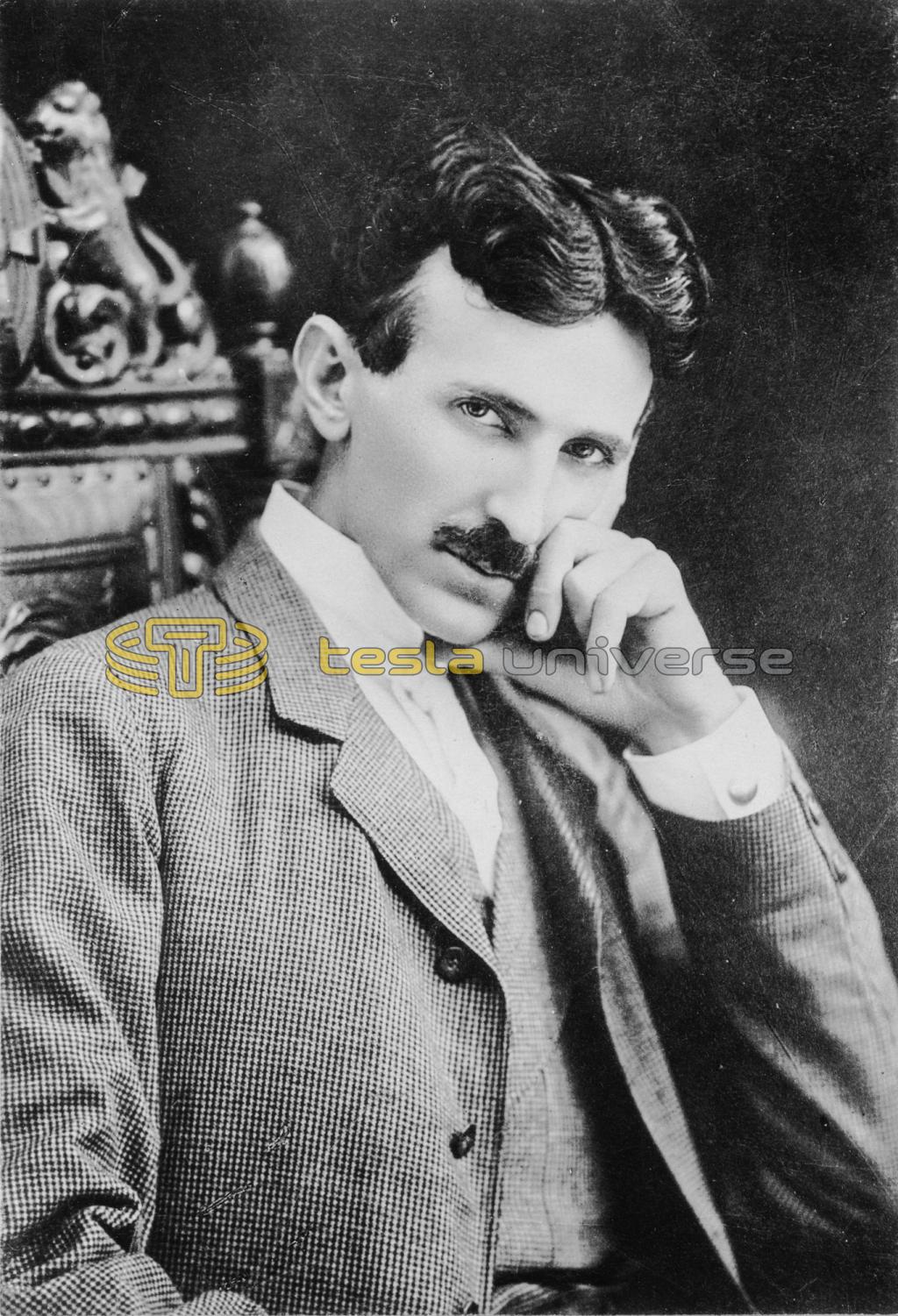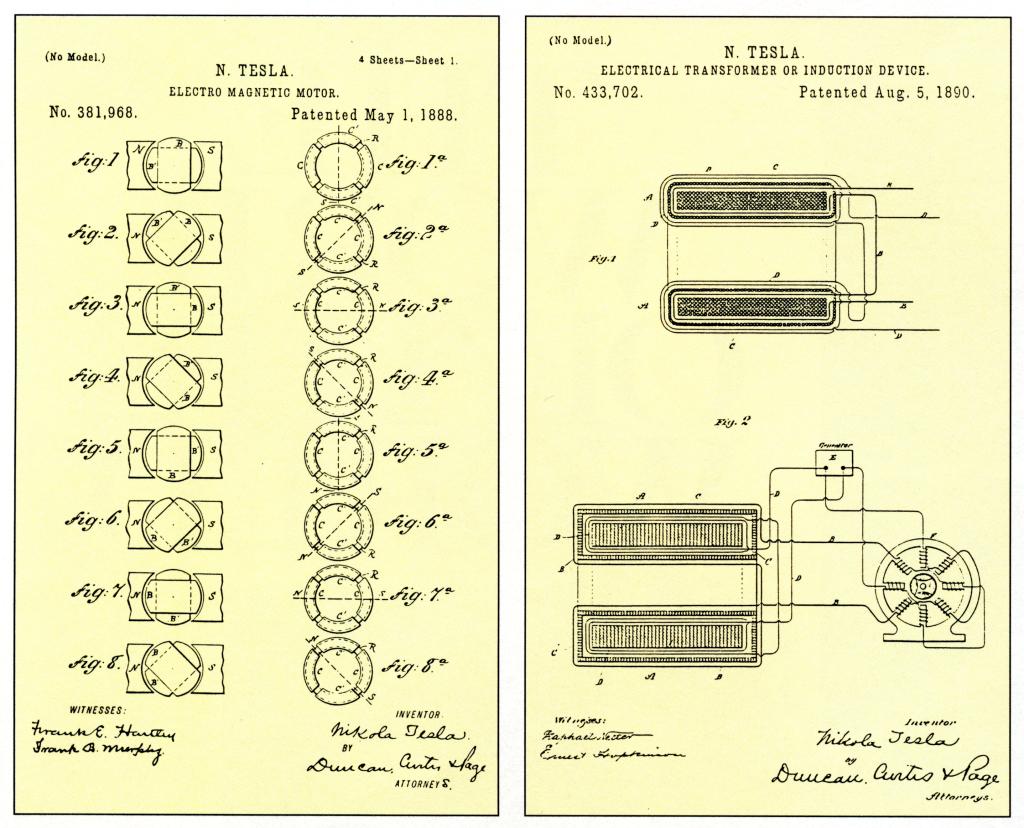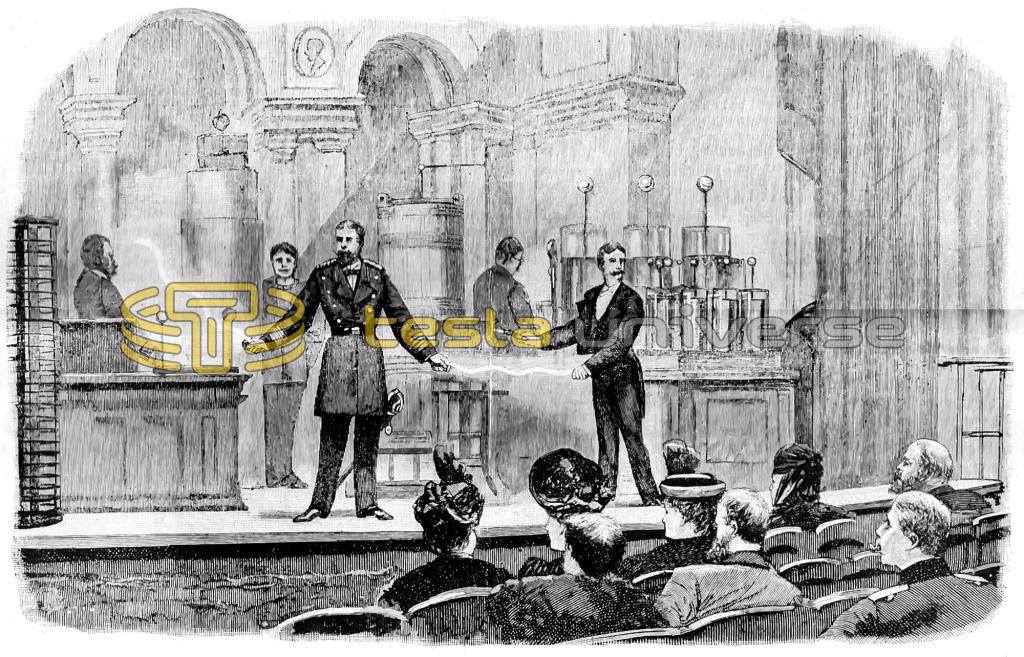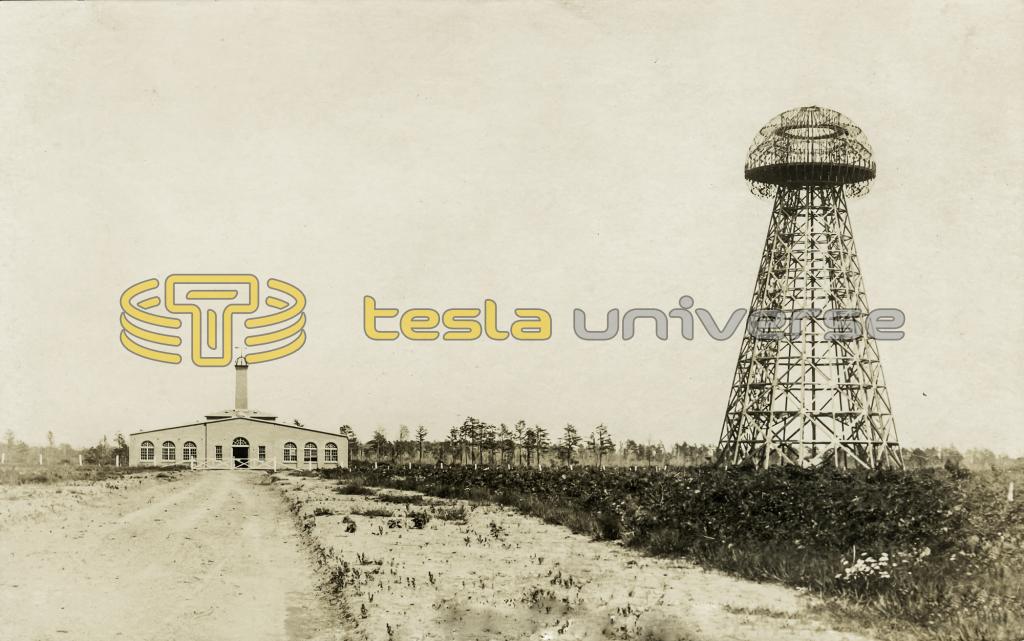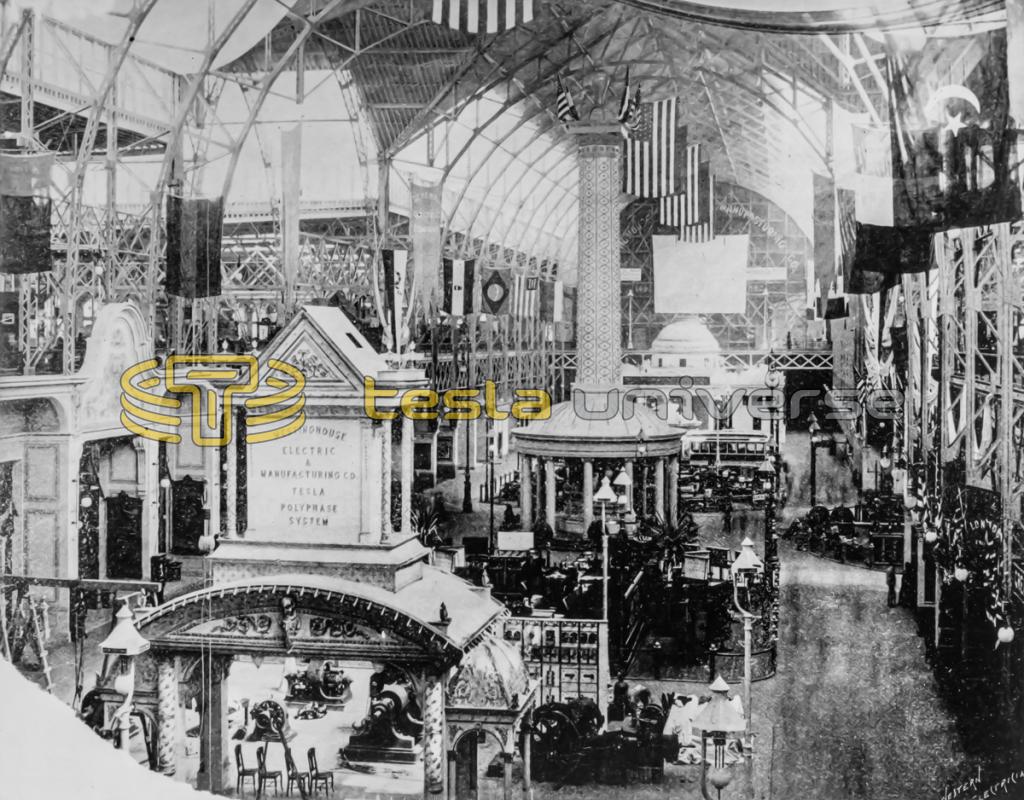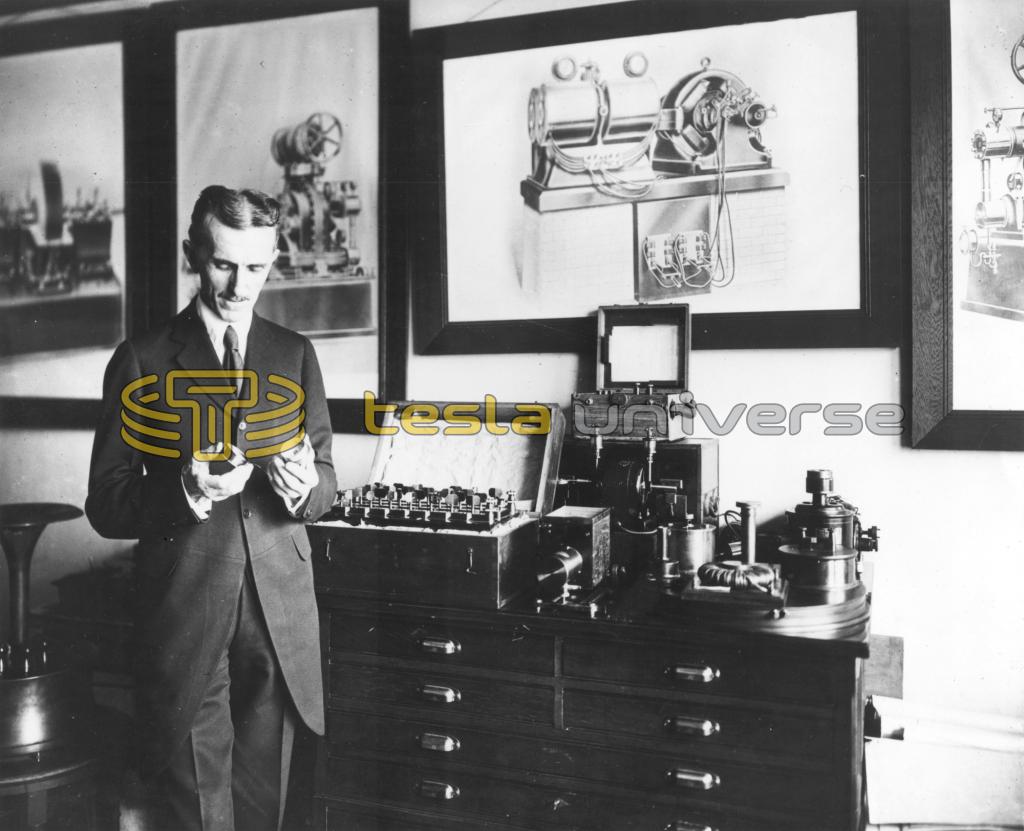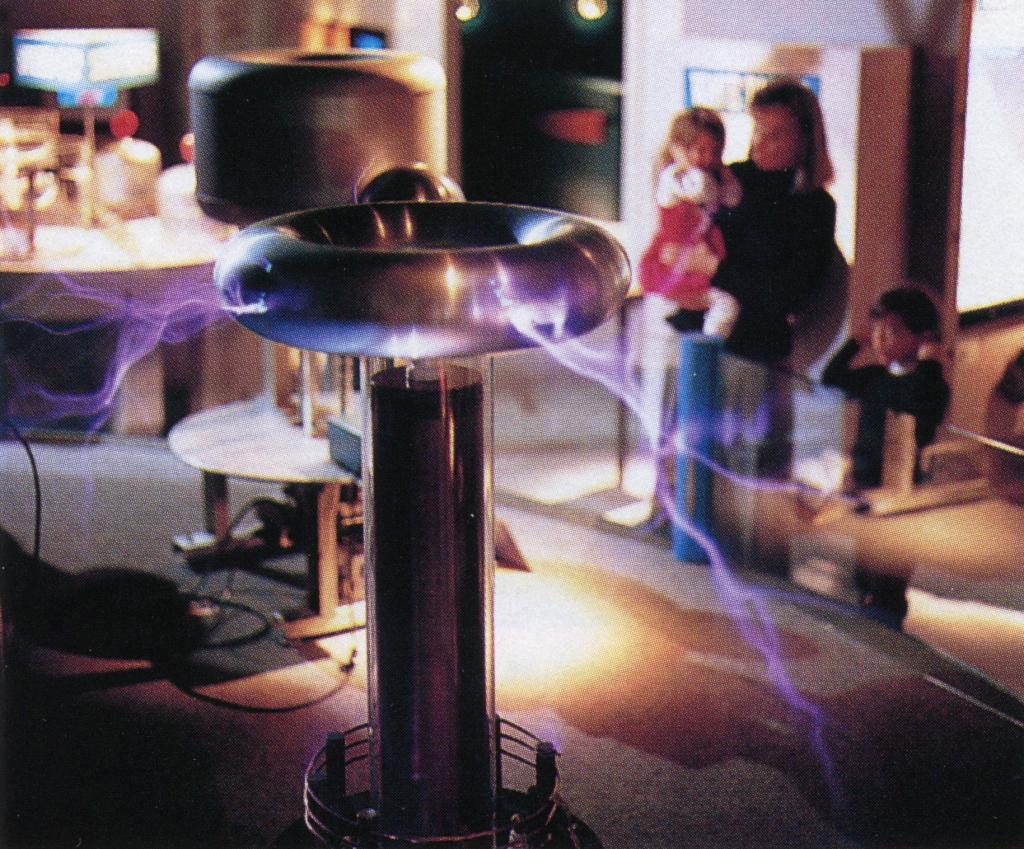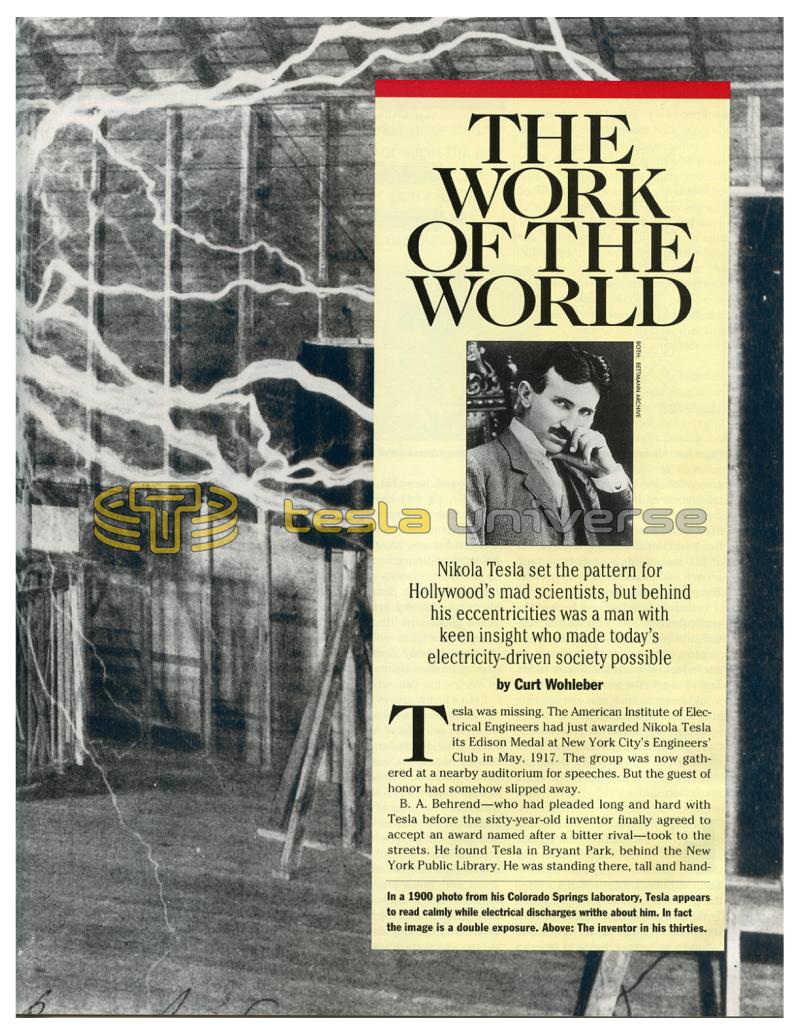
Nikola Tesla Articles
Nikola Tesla: The Work of the World
Tesla was missing. The American Institute of Electrical Engineers had just awarded Nikola Tesla its Edison Medal at New York City’s Engineers’ Club in May, 1917. The group was now gathered at a nearby auditorium for speeches. But the guest of honor had somehow slipped away.
B. A. Behrend - who had pleaded long and hard with Tesla before the sixty-year-old inventor finally agreed to accept an award named after a bitter rival - took to the streets. He found Tesla in Bryant Park, behind the New York Public Library. He was standing there, tall and handsome, dressed in crisp white tie and tails, covered from head to toe with pigeons. The birds snatched feed from his hands, perched serenely on his head, and milled about in a gray mass at his feet. Tesla saw Behrend approach and raised a finger to his lips. The pigeons scattered.
Tesla followed Behrend back to the auditorium. Behrend composed himself and addressed his colleagues: “Were we to seize and eliminate from our industrial world the results of Mr. Tesla’s work, the wheels of industry would cease to turn, our electric cars and trains would stop, our towns would be dark, our mills would be dead and idle...His name marks an epoch in the advance of electrical science. From that work has sprung a revolution....”
For a time, around the turn of the century, the reputation of Nikola Tesla very nearly eclipsed that of Thomas Edison. Edison had invented the practical incandescent lamp, but Tesla had devised the means to bring the electricity that would light those lamps to millions of homes in America and around the world, cheaply and efficiently. He was the toast of New York’s high society, throwing lavish dinner parties at Delmonico’s and the Waldorf-Astoria. After those dinners he would adjourn to his laboratory to entertain celebrity guests such as Mark Twain with demonstrations of electrical wizardry. In his hands glass tubes glowed to life wirelessly. He passed a million volts harmlessly through his body. Great electric coils gave off terrifying gouts of sparks. Balls of electric fire danced eerily.
Even a highly abbreviated list of Tesla’s achievements is impressive. There was the polyphase system, which made practical the large-scale electrification of America, and the Tesla coil, which produced high-frequency, high-voltage currents and later became an integral component of radio and then television equipment. His work with high-frequency electrical oscillations yielded crude prototypes of the cyclotron, the electron microscope, and neon and fluorescent lighting. He demonstrated a radio-controlled robot boat in 1898. He predicted global communications, computer science, and robotics with startling clarity.
Perhaps more than any other man, Tesla fitted the Hollywood stereotype of the eccentric scientist. His laboratory blazed and hummed with strange energies, and he himself had an otherworldly air about him. During electrical storms he liked to sit before a large window and, with childlike glee, watch the heavens rage. He eschewed romance, declaring it an unfit distraction for a man of science.
He had endless idiosyncrasies. An exaggerated fear of germs led him to demand his dinners be served accompanied by exactly eighteen napkins, with which he would meticulously polish his silverware; he could not enjoy a meal without first calculating its volume; the sight of pearl earrings made him ill. And he loved pigeons.
Nikola Tesla was born, it is said, during a thunderstorm at the stroke of midnight between July 9 and 10, 1856, in the village of Smiljan, Croatia. He was the son of Milutin, a minister, and Djouka, who was illiterate but had a prodigious memory and could recite vast amounts of poetry. It was from her, he maintained, that he inherited his inventive abilities; she had contrived many useful household devices.
As Tesla remembered his childhood, it was filled with many narrow escapes from death: on several occasions he nearly drowned; once he was almost boiled alive in a vat of hot milk; and he survived perilous encounters with dogs, hogs, and angry crows.
The phenomenon of static electricity entranced him. He once stroked the family cat and saw that its “back was a sheet of light, and my hand produced a shower of crackling sparks loud enough to be heard all over the place.” His mother told him to stop before he started a fire. His father explained that it was electricity, just like lightning.
Nikola was fascinated. “Is nature a giant cat?” he asked himself. “If so, who strokes its back?”
Mechanical things interested him early on. He took apart his grandfather’s clocks, though he had trouble putting them back together. At the age of five he built a bladeless waterwheel. (Interestingly, one of his last inventions of note was a bladeless turbine.) He also fashioned popguns, and arrows that he said could bore through an inch-thick pine plank.
Once he built a tiny motor powered by June bugs glued to a cross-shaped assembly mounted on a spindle. When the bugs tried to fly away, they turned a pulley, which drove the engine. The experiment ended when a local boy came by and began to eat his power supply.
He wanted to fly, and he noticed a peculiar buoyant sensation whenever he breathed deeply. From that he reasoned that if he hyperventilated enough, he might actually be able to float like a balloon. He tried this while leaping from the roof of a barn and holding an open umbrella. Neither deep breathing nor the improvised parachute prevented his plummeting to the ground and knocking himself out.
When he was twelve, he performed a slightly more sophisticated aeronautical experiment. The idea was to build a motor powered by atmospheric pressure, which would act on a cylinder partially enclosed by a box from which air had been evacuated - essentially a perpetual-motion device. He hoped to attach a propeller to this motor and fly away. When he assembled his engine and pumped the air out of the box, the cylinder indeed turned a little. He was thrilled, then dismayed when, rather than speeding up, the cylinder slowed to a halt. He later realized, much to his disappointment, that the cylinder’s feeble rotation had resulted from air leaking into the box.
In the classroom Tesla was a star pupil, especially - almost alarmingly so - in mathematics. He would blurt the answers to involved problems without putting pen to paper. In his autobiography, My Inventions, Tesla boasts of an amazing mental ability: If a particular object or figure came to his mind, he would see a vivid image of it before his eyes. This gift disturbed him, because sometimes particularly distressing scenes, such as a funeral, would suddenly intrude on his vision. But this odd capacity also enabled him to carry out complex arithmetic operations without a blackboard and later to design whole machines solely in his mind. From time to time he would also see strange flashes of light. “In some instances,” he wrote, “I have seen all the air around me filled with tongues of living flame.”
When Tesla suggested that a motor might run on alternating current, his professor gave a lecture explaining why it was impossible.
In 1870 the fourteen-year-old Tesla went off to school in the city of Karlovac, where he stayed with an aunt and uncle. He finished the four-year term at the Higher Real Gymnasium in three years. He also caught malaria, and he was still weak from it when he returned to his family in Gospic, Croatia, where they had moved when he was six. He came down with cholera. Things looked bleak on all fronts. Even if he recovered from the cholera, Tesla faced a compulsory three years of military service. Worse still, his father insisted that he enter the ministry instead of studying engineering. The predicament sapped his will to live. “I was confined to bed for nine months with scarcely any ability to move,” he recalled.
His father tried desperately to rouse him from his malaise. Then, when it looked as if he was going to die, Nikola whispered, “Perhaps I may get well if you will let me study engineering.” Overcome, Milutin Tesla told Nikola that he would go to the best technical institution in the world. That promise, along with “a bitter decoction of a peculiar bean,” restored Tesla’s health: “I came to life like another Lazarus to the utter amazement of everyone.”
At the advice of his father, Tesla spent the next year roaming the mountains, regaining his strength and, not incidentally, evading the draft. During this time he conceived a number of audacious inventions, including an ocean-spanning hydraulic tube for transporting mail at high speeds and an elevated ring circling the earth at the equator that would remain stationary as the earth turned within it, thus providing a simple means of rapid travel.
When his Wanderjahr was over, he entered the polytechnic institute in Graz, Austria, in 1875. Fiercely determined to penetrate the mysteries of electricity, he studied with an intensity that alarmed the dean of the engineering faculty, who wrote to Milutin that his son was working too hard.
During his second year in Graz, the school acquired a Gramme machine, a device consisting of a rotating conductive coil mounted between the ends of a horseshoe magnet. It could function as either a motor or a generator. If one turned the coil, its movement through the magnetic field would induce a current. Conversely, supplying an electric current to the coil would magnetize it, making it rotate within the field, thus providing mechanical power.
When it was functioning as a generator, the strength and direction of the current induced in the coil changed according to the coil’s orientation to the magnetic field. As the coil turned, the current increased to a maximum, decreased to zero, then began to increase again, but in the opposite direction.
What was created, then, was an alternating current (AC). A commutator - a hollow cylinder split lengthwise, with each segment connected to one end of the coil - enabled a set of brushes to exchange connections with the coil terminals twice per rotation, resulting in an intermittent current of constant direction.
The device intrigued Tesla, but the violent sparking where the commutator and brushes met struck him as intolerably inefficient. He raised his objections to his professor, a German named Poeschl, who replied that the problem with the sparking was “inherent in the nature of the machine. It may be reduced to a great extent, but as long as we use commutators it will always be present to some degree. As long as electricity flows in one direction, and as long as a magnet has two poles, each of which acts oppositely on the current, we will have to use a commutator to change, at the right moment, the direction of the current.”
“That is obvious,” said Tesla. “The machine is limited by the current used. I am suggesting that we get rid of the commutator entirely by using alternating current.”
Poeschl devoted his next lecture to demolishing Tesla’s proposal. “Mr. Tesla will accomplish great things, but he certainly never will do this. It would be equivalent to converting a steady pulling force like gravity into rotary effort. It is a perpetual motion scheme, an impossible idea.”
Tesla experienced an uncharacteristic moment of self-doubt. Was his idea really just a repeat of the flying-machine folly of his childhood? Before long, though, his confidence returned: “I could not demonstrate my belief at that time, but it came to me through what I might call instinct, for lack of a better name. But instinct is something which transcends knowledge.”
Tesla arrived in America with just the clothes on his back, a few coins, and a bundle of papers. He later spent a year as a ditchdigger.
Using his visualizing ability, he designed and mentally tested numerous AC motors. He slacked off on his studies to devote himself to the problem. He also took up card playing and billiards, which got him kicked out of the institute.
What happened next is unclear. He lost a great deal of money at cards, including some his parents had given him so that he could enroll at the University of Prague. He managed to win back the money and go to Prague, but there is no record that he ever enrolled at the university. One biographer suggests that he merely audited courses there for two years.
In any event, Tesla went to Budapest in 1881. The telephone was coming to Hungary, and he hoped to be part of this new cutting-edge technology. Instead he had to settle for a low-paying position as a draftsman with the government’s Central Telegraph Office. Once again Tesla became gravely ill. Physicians were mystified by the affliction. For lack of a better term, they called it a nervous breakdown.
“I could hear the ticking of a watch with three rooms between me and the time-piece,” Tesla wrote. “A fly alighting on a table in the room would cause a dull thud in my ear. A carriage passing at a distance of a few miles fairly shook my whole body. The whistle of a locomotive twenty or thirty miles away made the bench or chair on which I sat vibrate so strongly that the pain was unbearable.” Sunlight on his brow struck him with the force of a blow to the head.
But this illness passed as well, and soon Tesla took up the AC motor problem with renewed vigor. He took long walks through Budapest. Tesla recounted one such walk, through a city park with a friend named Anital Szigety, a mechanic, in memoirs he published in 1915. At one point Tesla gazed at a particularly beautiful sunset and remembered some lines from Goethe’s Faust:
The glow retreats, done is the day of toil;
It yonder hastes, new fields of life exploring;
Ah, that no wing can lift me from the soil;
Upon its track to follow, follow soaring!
He stopped suddenly and fell into a trance. He had the key to building an AC motor; he could see it right in front of his eyes. He began sketching it in the dirt with a stick.
“Watch me,” he told Szigety. “Watch me reverse it.”
Szigety gestured toward a nearby bench and suggested that he sit down and rest.
“Don’t you see it?” said Tesla. “See how smoothly it is running? Now I throw this switch - and I reverse it. See? It goes just as smoothly in the opposite direction. Watch! I stop it. I start it. There is no sparking. There is nothing on it to spark!”
Szigety was baffled. “Are you ill?” he asked.
“It is my alternating-current motor I am talking about. I have solved the problem. Can’t you see it right here in front of me, running almost silently? It is the rotating magnetic field that does it. See how the magnetic field rotates and drags the armature around with it? Isn’t it beautiful? Isn’t it sublime? Isn’t it simple?” He smiled beatifically. “Now I can die happy. But I must live, I must return to work and build the motor so I can give it to the world. No more will men be slave to hard tasks. My motor will set them free, it will do the work of the world.”
Whether or not he really had such a glorious moment of inspiration, Tesla had finally figured out how to build an electric motor that dispensed with the commutator and brushes. His solution was to run two or more out-of-phase alternating currents through the stator, or stationary outer portion of the motor. These currents would induce currents in the rotor, or armature - the inner, rotating portion. With a properly controlled phase relationship, the currents in the stator would create a rotating magnetic field. The induced currents in the rotor would create another magnetic field, at an angle to the one created by the stator currents. This would cause the rotor to turn, as the opposite poles of the two magnetic fields attracted each other. This breakthrough became known as the polyphase system.
Retreating again to his mental laboratory, Tesla built a series of imaginary motors, dynamos, and transformers. He later said that he was able to test his prototypes by running them for weeks on end and periodically checking them for signs of wear.
Soon afterward he got a job with the Continental Edison Company in Paris. He tried to interest his employers in the polyphase system, but Edison’s antipathy to alternating current was well known. Tesla nevertheless distinguished himself as a crack troubleshooter, directing the repair of Edison power stations in France and Germany. While on assignment in Alsace he built his first actual prototype, a two-phase AC induction motor. It worked beautifully, but the only person who expressed any commercial interest in it was the mayor of Strasbourg, who tried without success to recruit some local investors.
Back in Paris, Charles Batchelor, a friend and close business associate of Edison, told Tesla that he ought to seek his fortune in America. Tesla arrived in the United States in 1884. He had lost his luggage on his way to the steamship, so he arrived in New York with just the clothes on his back, a few coins, and a bundle of papers, mostly technical articles and poems he had written. He earned twenty dollars on his first day by fixing a machine for a grateful Manhattan shopkeeper. The next morning, armed with a letter of introduction from Batchelor, he called on Edison at his laboratory on Pearl Street. The great inventor, impressed with Tesla’s credentials, hired him to repair a malfunctioning electrical system on a steamship.
The cultured, fastidious Tesla and the slovenly, folksy Edison were uniquely mismatched. Unable to find Croatia on a map, Edison once asked Tesla if he had ever eaten human flesh. They differed in inventive philosophy as well as personality. Edison took an almost perverse pride in his plodding trial-and-error approach to problem solving. Tesla, whose inventions existed fully formed in his head before he began to build them, found Edison’s “empirical dragnets” distasteful. “If Edison had a needle to find in a haystack,” he said later, “he would proceed at once with the diligence of the bee to examine straw after straw until he found the object of his search. I was a sorry witness of such doings, knowing that a little theory and calculation would have saved him ninety percent of his labor.”
Despite their differences, Tesla impressed Edison with his skill and hard work. For months the young immigrant worked from 10:30 a.m. to 5:00 a.m. the next day, seven days a week. He presented a plan to improve the efficiency of Edison’s dynamos. Edison said he would give him $50,000 if he could make the scheme work. Tesla labored feverishly on the project, and the improved dynamos did everything he said they would.
Then he asked Edison for the $50,000 he had been promised. Edison was taken aback. “Tesla, you don’t understand our American humor,” he said. Tesla was unamused. Edison made a counter offer: a ten-dollar-a-week raise. Tesla quit on the spot.
Soon afterward a group of investors approached Tesla with a proposal to form a new company to develop and market arc lights. As head of the Tesla Electric Light Company, he devised a safer, more reliable arc lamp than the ones generally in use at the time. For his effort, the investors paid him in stock certificates, which were virtually worthless because the United States was in the grip of the economic crisis that followed the Panic of 1884. He was forced out of the company, and he spent the next year working as a laborer on the streets of New York.
The foreman of his ditchdigging gang was moved and impressed by Tesla’s story and introduced him to a Mr. A. K. Brown of Western Union, who helped Tesla form a new firm, the Tesla Electric Company. With financial backing and his own lab just a few blocks from Edison’s, Tesla set to work building motors, dynamos, and transformers. In addition to his polyphase system, he developed single - and split-phase AC motors, which were less efficient but useful for special applications, or where a polyphase current was unavailable or impractical. Over the next several years Tesla received forty patents related to his AC system.
In May 1888 he lectured to the American Institute of Electrical Engineers. His address, “A New System of Alternate Current Motors and Transformers,” created a sensation within the profession. Among those impressed by Tesla’s vision was George Westinghouse, the Pittsburgh businessman and inventor of the Westinghouse air brake for trains. Westinghouse had secured American rights to a transformer, patented by Lucien Gaulard and John Gibbs, which was used to supply high-voltage alternating current for arc lighting.
William Stanley had greatly improved the Gaulard and Gibbs transformer, and in 1886 Stanley electrified eighteen businesses in Great Barrington, Massachusetts. (See “William Stanley’s Search for Immortality,” by George Wise, Invention & Technology, Spring/Summer 1988.) Westinghouse declared that AC had arrived. Alternating current had a great advantage over the direct-current system marketed by Edison. Low-voltage direct currents dissipated rapidly, limiting the transmission radius of every generating station to a few miles. Stanley’s transformer made it feasible to step up an alternating current to a high voltage, at which it could be transmitted efficiently across long distances.
But the system suffered from the lack of a practical motor it could power. Tesla’s key patents filled that void. Westinghouse visited Tesla at his laboratory and nodded appreciatively as the inventor demonstrated his quietly humming machines. The two men made a deal: Tesla would get approximately $60,000 in cash and stock, plus a $2.50 royalty for every horsepower of motor or generating capacity sold.
As word of Westinghouse’s plans spread, Edison, sensing a threat, prepared to strike back. The “War of the Systems” was one of the most down-and-dirty public battles in the annals of American business. Edison set out to convince the American people that alternating current, with its high voltages, represented a menace to anyone who dared let it into his home, a tactic he had used with considerably more justification when persuading people to give up gas-lighting for DC power and incandescent bulbs.
In West Orange, New Jersey, the home of his sprawling new invention factory, Edison offered local children a twenty-five-cent bounty for stray dogs and cats. Pets suddenly disappeared. Edison had hired a New York engineer named Harold Brown to document the menace of alternating current and explore its use as a means of execution. One corner of Edison’s renowned center of beneficial innovations became a chamber of horrors as Brown “Westinghoused” dogs and cats and later calves and horses.
In 1888 New York State adopted electrocution as its official mode of capital punishment. Brown surreptitiously secured a license on several Tesla patents, and two years later William Kemmler, a convicted murderer, was the first man to be executed in Sing Sing prison’s new electric chair. It was a grisly, protracted affair. Kemmler survived the first jolt, and the current had to be administered again. “They could have done better with an axe,” commented Westinghouse.
The American public accepted alternating current anyway. And eventually so did Edison’s company. A ruthless price war forced Edison to merge with Thomson-Houston, which used AC for arc lighting, and a new company known as General Electric was born.
In 1893 Westinghouse underbid General Electric and won the contract to light the Chicago world’s fair. Working on short notice, Tesla cobbled together a dozen 1,000-horsepower AC generators. Celebrating (a year late) the 400th anniversary of the discovery of America, twenty-five million visitors mobbed Chicago and beheld such technological wonders as Thomas Edison’s early motion-picture system, music transmitted live from New York via telephone, and an early prototype of the zipper. More courageous visitors enjoyed the thrill of riding G. W. G. Ferris’s 250-foot wheel.
Tesla, nattily dressed as always, amazed audiences with an electric clock, glowing phosphorescent tubes, and spectacular discharges from mammoth electric coils. He sent 200,000 volts of high-frequency current through his body. A newspaper reporter wrote that Tesla was surrounded by “dazzling streams of light.”
That same year, Westinghouse won the contract to build three AC generators at Niagara Falls (the distribution contract went to GE). Years earlier Tesla had daydreamed about harnessing the enormous power of that thundering curtain of water. Now it was to become a reality. Huge turbines were built, and in 1895 the first three 5,000-horsepower two-phase generators went on-line. One of the first customers was the Pittsburgh Reduction Company, which later became the Aluminum Company of America (now Alcoa). Cheap, plentiful electric power from the Falls made possible the large-scale commercial production of aluminum, and in the years that followed Niagara Falls became the center of the electrochemical industry. By the end of 1896 a twenty-six-mile transmission line carried current to power the lights and streetcars of Buffalo.
Alternating current was going to take over the world, but Tesla himself would profit little from that conquest. Westinghouse extended himself perilously in pushing the system. When Charles Coffin, a crony of J. P. Morgan and president of Thomson-Houston, tried to enlist him in a price-fixing scheme, Westinghouse refused. Rumors of mismanagement and imminent bankruptcy circulated on Wall Street, and his stock plummeted. The company had to merge with several smaller firms. Westinghouse Electric would be saved, but the bankers who had put the deal together pointed to one fatal liability: Tesla’s $2.50-per-horsepower royalty. It would have to go.
Westinghouse went to Tesla’s laboratory in 1896 to deliver the bad news in person. He explained the situation: Tesla must give up the royalties or the company would go under, taking his polyphase system with it. Tesla tore up the original contract and let Westinghouse buy his system outright for $216,000. He probably could have struck a deal satisfactory to the bankers while still ensuring himself lifelong prosperity, but Tesla most likely believed there would be plenty more money from other sources.
He built imaginary models of his inventions and ran them in his mind for weeks on end, periodically checking for signs of wear.
The last decade of the century saw Tesla at the zenith of his creative powers. In 1891 he had demonstrated the Tesla coil, an air-core step-up transformer and capacitor capable of converting high currents at low voltage to low currents at high voltage, all at high AC frequencies. He also began to experiment with ways of transmitting electricity wirelessly. A few years before, Heinrich Hertz had discovered the propagation of electromagnetic waves through space, and in his own lab Tesla noticed that sending a current through a coil of a specific frequency would elicit sparks from other coils tuned to either the same frequency or one of its harmonics. He foresaw a day when telegraph signals and electric power would be transmitted all over the world without wires, and he filed several key patents describing wireless transmitters and receivers.
Tesla’s experiments were interrupted in 1895, when fire reduced his laboratory to a smoking, half-melted ruin. He had no insurance. Fortunately Edward Dean Adams, whose Cataract Construction Company had awarded Westinghouse the Niagara Falls generator contract, came through with $40,000 and suggested forming a new company with Tesla, capitalized at $500,000. Tesla, prizing his independence, declined the offer. He set up shop on East Houston Street and quickly returned to work, agonizing as the new equipment trickled in by rail.
Three years later, at the Electrical Exhibition in New York City’s Madison Square Garden, 15,000 people watched Tesla demonstrate a remote-control model boat, an astounding feat considering that radio technology was still embryonic. War had broken out with Spain earlier that year, and Tesla hoped to sell his “teleautomatic” system to the government, but the military men found the idea of robot boats too exotic.
His work with wireless transmission intensified. With funding from John Jacob Astor and others, Tesla built a research station in Colorado Springs, where he promised to send a wireless signal from Pikes Peak to Paris in time for the 1900 Paris Exposition. He stayed in Colorado Springs for eight months, generating huge voltages and making the skies above the sleepy town crackle and flash. He asserted that before long he would be in communication with the intelligent beings that undoubtedly inhabited Mars, but he never even reached Paris.
There is a famous photograph of Tesla at Colorado Springs. It shows him sitting among his huge coils, reading calmly, as enormous jagged electrical discharges writhe about him. The picture was typical Tesla showmanship: not pure hokum, but not quite what it seemed to be either. The shot was a double exposure, Tesla’s image added to the photograph while the coils were safely dormant.
Back in New York Tesla persuaded J. P. Morgan to provide $150,000 to finance another attempt at intercontinental wireless communication. He built a 187-foot tower called Wardenclyffe near Shoreham, Long Island. Stanford White helped with the design. As it was going up, Guglielmo Marconi managed to beat Tesla in sending a wireless telegraphic signal across the Atlantic. “Let him continue,” Tesla said. “He is using seventeen of my patents.”
Morgan’s $150,000 ran out before Wardenclvffe was complete. Tesla blamed the banker’s financial machinations. “You have raised great waves in the industrial world,” he wrote, “and some have struck my little boat. Prices have gone up in consequence twice, perhaps three times higher than they were....” Morgan refused to extend any more money, despite a series of increasingly desperate pleas from Tesla. The project had to be abandoned.
The “World System” he had hoped to pioneer at Wardenclyffe was Tesla’s last large-scale endeavor, his final opportunity to sustain his reputation as one of the towering figures of American invention. But he had been too ambitious, too impractical. His scientific knowledge failed to keep up with the times. Revelations about atomic structure, relativity, and quantum theory passed him by. Even his knowledge of electrical phenomena was largely empirical; when he conceived his polyphase system in the 1880s, J. J. Thomson had yet to describe the electron.
Though Tesla would survive into the 1940s, his important scientific work was largely completed by the turn of the century. In the last decades of his life he faced mounting financial hardship. He was evicted from his beloved Waldorf-Astoria and took up residence in a series of progressively less fashionable hotels. Growing old and desperately in need of money, he turned his hand to some less visionary projects and enjoyed modest success with an improved locomotive headlight and a speedometer. His bladeless turbine showed great promise, but it never caught on. In the past two decades, however, interest in his turbine has grown, and it may soon find application in generators and jet aircraft.
When Marconi sent a wireless signal across the Atlantic, Tesla said, “Let him continue. He is using seventeen of my patents.”
Late in life Tesla’s eccentricities grew ever more pronounced, particularly his almost fanatical devotion to pigeons. He spent hours feeding them in the park behind the library. If he came across one that was sick or injured, he would take it back to his hotel room, much to the dismay of the management.
John O’Neill, a young science writer and friend of the aging Tesla, once visited him at the Hotel New Yorker with William L. Laurence, a fellow journalist. In the hotel lobby Tesla, O’Neill recalled, told them a story about a white pigeon.
“I have been feeding pigeons,” he began, “thousands of them, for years. Thousands of them, for who can tell -”
There was one pigeon of which he was particularly fond: pure white, with light gray wing tips. “No matter where I was, that pigeon would find me; when I wanted her I had only to wish and call her and she would come flying to me. She understood me and I understood her.
“I loved that pigeon.
“Yes, I loved her as a man loves a woman, and she loved me... As long as I had her, there was purpose in my life.” One night, he continued, the white pigeon flew through the window and landed on his desk. He knew that she was dying. “And then... there came a light from her eyes - powerful beams of light. Yes, it was a real light, a powerful, dazzling, blinding light, a light more intense than I had ever produced by the most powerful lamps in my laboratory.
“When that pigeon died, something went out of my life....I knew my life’s work was finished.”
When O’Neill and Laurence left him that night, they walked for many blocks without speaking. Years later O’Neill wrote, “It is out of such phenomena as Tesla experienced” - in his hotel room and in that park in Budapest -“... that the mysteries of religion are built.”
Tesla died alone in his hotel room in January 1943. Less than a year later the U.S. Supreme Court voided Marconi’s primary wireless patent in favor of a 1900 Tesla patent.
Today Tesla’s name, while hardly forgotten, is unknown to many. His accomplishments, significant as they were, are not concretely present in everyday life the way Thomas Edison’s light bulb is. Yet Tesla’s voice can still be heard, on quiet nights when the sounds of traffic recede and one can hear the steady hum of power lines, carrying on the work of the world.
Curt Wohleber, a former senior editor of Invention & Technology, is a communications specialist at the University of Pittsburgh. He wrote about the origins of transatlantic steamship travel in the Spring/Summer 1991 issue.
